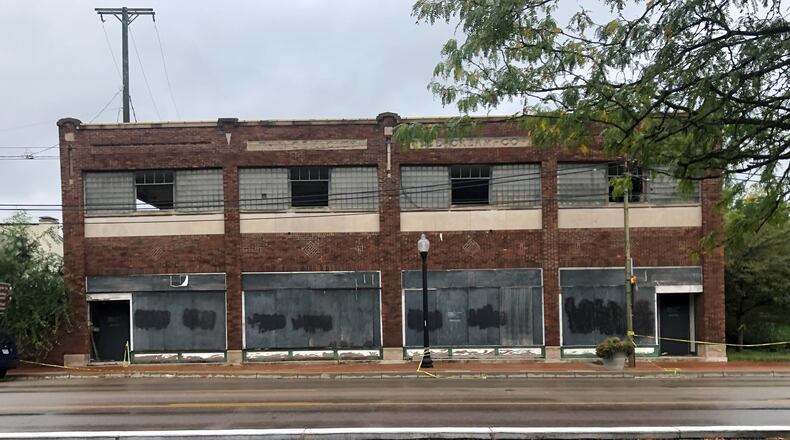The commission’s denial came after members of historic preservation groups wrote messages and spoke out against the proposal to completely raze the commercial building, located at 1005 W. Third St. in the Wright Dunbar business district.
Members of Preservation Dayton Inc. said keeping the building’s façade and incorporating it into a redevelopment project would make the project eligible for historic tax credits.
“Once the building is entirely demolished, we lose a key asset for potential developers,” said Monica Snow, a trustee with Preservation Dayton. “We don’t think complete demolition is the way to go.”
City staff said the property is a public nuisance and safety hazard.
Staff said the structure is not salvageable given its extremely deteriorated condition after years of disuse and neglect, and there’s been no interest from developers to rehab the building.
“It could collapse tonight, it could stand for another three years — nobody knows,” said Dennis Zimmer, Dayton’s nuisance abatement program supervisor. “But it is truly an emergency that we do something with this building in the very near future.”
Constructed in the late 1800s, the property was briefly home to the Wright brothers’ first bicycle shop — likely for about six months — but it was later acquired by the Gem City Ice Cream Co., which built multiple additions and operated out of the space for decades.
The city acquired the building in 1998, a few years after a utility tenant moved out, and the property has been in Dayton’s nuisance program since 2008.
A 2007 evaluation of the property by Shell + Meyer Associates Inc. noted it was constructed before modern building codes were developed and steel inside the concrete pillars is rusting, according to a staff report for the landmarks commission.
A western wall of the building is in danger of collapse, and partial demolition of the property is not a feasible option since it is set up like a “house of cards,” meaning removing one section could lead to a total collapse, the report states.
A more recent evaluation in 2019 by licensed engineer John L. Geiger concluded that the building cannot be salvaged under any circumstances.
The property was not properly maintained decades before the city acquired it, staff said.
Some neighbors want the building torn down, claiming it is a long-time neighborhood eyesore and its redevelopment seems implausible.
“We have come to the conclusion and understanding that the renovation of the building isn’t feasible,” said Jeff Jackson, president of Wright-Dunbar Village, in an email to the city.
Dan Barton, a trustee with Preservation Dayton’s board, said he knows a couple of potential developers that are interested in the site, and the façade can be part of a historic adaptive reuse project.
“This is a potentially very attractive site,” he said. “I work on projects in Cincinnati — I’ve got four in Over-the-Rhine — and this is a standard redevelopment project in Over-the-Rhine.”
Seth Maney, a Cincinnati real estate developer who grew up in Oakwood and attended the University of Dayton, told the Landmarks Commission on Thursday evening he thinks the façade can be saved and he is interested in the property.
Maney said he helped redevelop more than 100,000 square feet of space of historic properties using historic tax credits in Over-the-Rhine, which is one of Cincinnati’s most vibrant neighborhoods.
“I’ve seen facades just like that brought back,” he said.
Despite the Landmarks Commission’s denial, the city could still tear down the building through emergency demolition if city officials determine it is an immediate public safety threat.
“We don’t stand in front of this board asking to tear down historic buildings on a regular basis,” said Todd Kinskey, Dayton’s director of planning, neighborhoods and development. “This is something that is a very serious matter for us, and we’re worried about it collapsing.”
Kinskey said economic development staff have taken numerous developers on tours of the building but none were interested because they could not afford the renovation costs.
“This is not Over-the-Rhine,” he said. “The real estate values are much different, and the market is a lot different.”
However, he said, some developers have expressed interest in the site if the decaying structure is removed.
If the building is demolished, city staff committed to requiring developers who respond to a request for proposals to reuse the site to incorporate any salvaged historic materials into their projects, such as the Gem City Ice Cream Co. sign.
But Landmarks Commission members like Burgess Gow think there’s still hope for the property.
He said the city can inform potential developers they can tear down most of the building if they save the façade ― which could make a big difference.
“If the façade can be saved, and you can get tax credits ... that just seems like a no-brainer,” he said.
Landmarks Commission member Scott Sliver said the city has owned the property for a couple of decades and he sees no reason to rush to approve demolition when people have come forward expressing interest in potential redevelopment projects.
“To me it only makes sense to give them a shot to look at it,” he said.
About the Author



